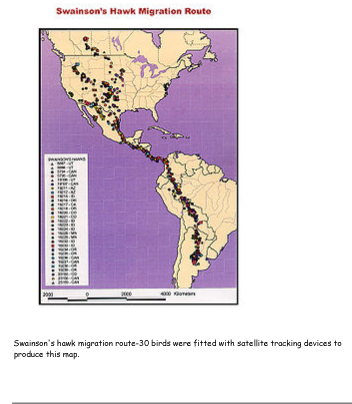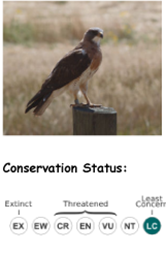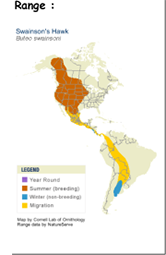Learn About Swainson’s Hawk
The Swainson’s Hawk (Buteo swainsoni), is a large hawk. This bird was named after William Swainson, a British naturalist. A common color pattern for the adult Swainson’s Hawk is dark brown plumage with a brown chest and a pale belly. In western North America, their breeding habitat is prairie and dry grasslands.
Swainson’s hawk is probably the longest long distant migrant of any North American raptor, wintering in Argentina. Each migration can last at least two months. In a life span of seven or eight years, a Swainson’s hawk might cover as much as 15,000 miles (24,000 km) during its migrations north and south!

It favours wild prairie, hayfields, and pastures over wheat fields which may offer its prey too much cover. It requires elevated perches for hunting and a supply of small mammals such as young ground squirrels as prey for its nestlings. When not nesting, the Swainson’s Hawk can be largely insectivorous taking grasshoppers, crickets and locusts. The breeding distribution of the Swainson’s hawk is tied very closely to the distribution of various small mammals for this reason.
The Swainson’s Hawk normally lays up to 1-4 eggs. The incubation period is 34 to 35 days, with the female incubating while the male brings food. Swainson’s require trees for nesting and is found around aspen groves, riparian areas, and farmlands. They build a stick nest in a tree, shrub or on a cliff edge. When Swainson’s Hawks arrive at their nesting sites in March or April, they may return to their original nests as these hawks are noted to be monogamous. Research indicates that they have a high degree of mate and territorial fidelity. This is an unusual occurrence in a long distance migrant.
The oldest wild Swainson’s Hawk on record is 24 years. Swainson’s Hawks die because of collisions with traffic, illegal shooting, electrocution, and even during severe prairie weather such as hailstorms.
They are declining in some parts of their range due to loss of habitat. Although the use of DDT has been banned in the United States, the Swainson’s Hawk still encounters pesticide use when it migrates in the winter to Argentina. Known as the locust hawk, the hawks will eat numerous amounts of these insects and in turn ingest a high amount of toxin, which causes thinning of egg shells. The bird is often quite tame and remains an easy target for shooters traveling isolated prairie roads.

Scientific Classification:
- Kingdom: Animalia
- Phylum: Chordata
- Class: Aves
- Order: Falconiformes
- Family: Accipitridae
- Genus: Buteo
- Species: B. swainsoni

References: This article incorporates text from the Bureau of Land Management which is in the public domain. * BirdLife International (BLI) (2008). Buteo swainsoni. 2008 IUCN Red List of Threatened Species. IUCN 2008. Retrieved on 27 December 2008. * Bollmer, Jennifer L.; Kimball, Rebecca T.; Whiteman, Noah Kerness; Sarasola, José Hernán & Parker, Patricia G. (2005): Phylogeography of the Galápagos hawk (Buteo galapagoensis): A recent arrival to the Galápagos Islands. Mol. Phylogenet. Evol. 39(1): 237–247. * Goldstein, M.I.; Woodbridge, B.; Zaccagnini, M.E.; Canavelli, S.B. & Lanusse, A. (1996): An assessment of mortality of Swainson’s hawks on wintering grounds in Argentina. Journal of Raptor Research 30(2): 106–107. * Laverde-R., Oscar; Stiles, F. Gary & Múnera-R., Claudia (2005): Nuevos registros e inventario de la avifauna de la Serranía de las Quinchas, un área importante para la conservación de las aves (AICA) en Colombia [New records and updated inventory of the avifauna of the Serranía de las Quinchas, an important bird area (IBA) in Colombia]. Caldasia 27(2): 247-265 * Olmos, Fábio; Pacheco, José Fernando & Silveira, Luís Fábio (2006): Notas sobre aves de rapina (Cathartidae, Acciptridae e Falconidae) brasileiras [Notes on Brazilian birds of prey]. Revista Brasileira de Ornitologia 14(4): 401-404 * Sibley, David Allen (2000): The Sibley Guide to Birds. Alfred A. Knopf, New York.

